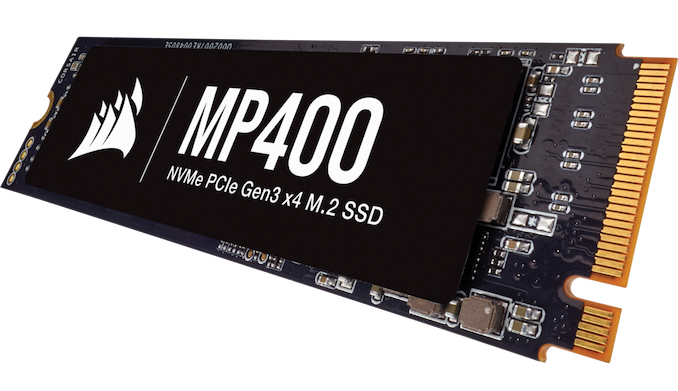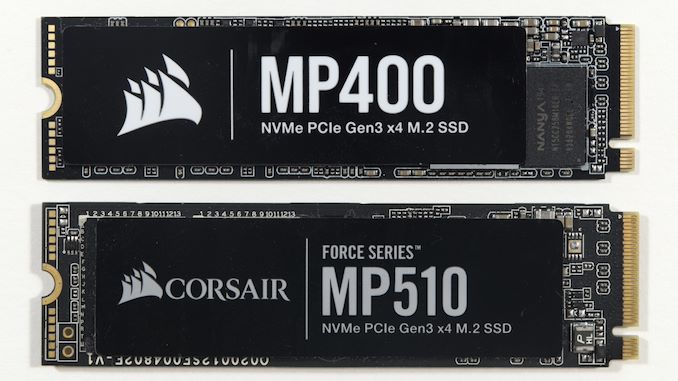The Corsair MP400 1TB QLC NVMe SSD: A Quick Review
by Billy Tallis on December 11, 2020 2:00 PM EST
Following up from our recent look at 8TB QLC SSDs, today we're taking a look at the 1TB Corsair MP400. This is a QLC NVMe SSD using the Phison E12 controller, which puts it a step up from earlier QLC SSDs that used four-channel Silicon Motion controllers. Unlike last week's review of 8TB SSDs, this time we're dealing with a much more affordable capacity of 1TB. At 8TB, many of the downsides of QLC NAND can be overcome by the sheer volume of flash memory, but this 1TB drive falls toward the low end of the QLC SSD capacity range and faces real competition from entry-level drives using TLC NAND.
Corsair MP400
The MP400 is Corsair's answer to Sabrent's Rocket Q and other similar SSDs that have adopted the combination of the Phison E12S controller and QLC NAND. Compared to the Sabrent Rocket Q, Corsair's specifications for the MP400 are a bit more optimistic on performance and a bit lower on the write endurance rating, but we expect the real-world differences between these drives at the same capacity to be insignificant given the near-identical hardware.

Corsair MP400 1TB (QLC) and the Corsair Force MP510 (TLC)
Sabrent's Rocket Q product line covers capacities from 500GB to 8TB. Corsair drops the 500GB option, which is very reasonable: we consider 1TB to be the bare minimum for a QLC drive to make sense. That's especially true of these drives that use an 8-channel Phison E12S controller, half of which goes unused on a 500GB QLC model. Mushkin's recently announced ALPHA series goes even further and will only offer 4TB and 8TB options.
| Corsair MP400 Specifications | |||||
| Capacity | 1 TB | 2 TB | 4 TB | 8 TB | |
| Form Factor | M.2 2280 PCIe 3 x4 | ||||
| Controller | Phison E12S | ||||
| NAND Flash | Micron 1Tbit 96L 3D QLC | ||||
| Sequential Read (MB/s) | 3480 | ||||
| Sequential Write (MB/s) | 1880 | 3000 | |||
| Random Read IOPS (4kB) | 190k | 380k | 610k | ||
| Random Write IOPS (4kB) | 470k | 560k | 710k | ||
| Power Consumption | 4.0 W | 5.5 W | 6.5 W | 6.5 W | |
| Warranty | 5 years | ||||
| Write Endurance | 200 TB 0.1 DWPD |
400 TB 0.1 DWPD |
800 TB 0.1 DWPD |
1600 TB 0.1 DWPD |
|
| Current Retail Prices | $114.99 (11¢/GB) |
$244.99 (12¢/GB) |
$662.00 (17¢/GB) |
$1498.00 (19¢/GB) |
|
The 1TB capacity point is currently the volume spot in the consumer SSD market for QLC, with the most competition and the best prices on a per-GB basis. QLC SSDs have made multi-TB SSDs more affordable, but 2TB and larger drives still tend to carry a premium. In the entry-level NVMe market segment, there's overlap at 1TB between DRAMless TLC designs and QLC with DRAM designs, two markedly different strategies for cutting costs. There are thankfully only a handful of DRAMless QLC NVMe drives that combine both weaknesses. There are also a few relatively budget-oriented TLC SSDs with DRAM that hit low price points using cheaper 4-channel controllers.

Corsair MP400 1TB (QLC, Top) and the Corsair Force MP510 (TLC, Bottom)
Each of these approaches to an entry-level NVMe SSD (QLC+DRAM vs TLC without DRAM) comes with its own typical weaknesses, and some advantages. DRAMless SSDs will suffer under workloads with heavy random IO, but where they do offer decent performance they tend to have very good power efficiency - not having to power any external DRAM chips helps. QLC SSDs suffer most during sustained writes, and are very heavily reliant on their SLC caches. Smaller drives have smaller SLC caches, so it will be much easier to overflow that write cache on this 1TB MP400 than on the larger variants. Most QLC and TLC drives tend to use SLC caches, but QLC drives also tend to use the largest SLC cache sizes possible, which exacerbates the performance problems once the cache is full - there's little or no empty flash left that could be written to directly as QLC, and until the drive can catch a break, further writes will require compacting data from the SLC cache into QLC blocks to free up space.
Most drives using 4-channel controllers have notably limited throughput. SK hynix was first to market with a 4-channel drive that could saturate PCIe 3 x4 (with TLC NAND), and that Gold P31 is priced more like a high-end drive. Silicon Motion has introduced a 4-channel Gen4 controller that is also more than fast enough for a Gen3 x4 interface, but it also is not yet cheap enough for entry-level drives. So for now, the 8-channel Phison E12 controller is the best option for high-capacity QLC SSDs to improve performance.
This review has two main points of comparison for our 1TB Corsair MP400 sample: the 8TB Sabrent Rocket Q we recently reviewed is the most similar, and lets us see how this Phison E12+QLC design scales down to smaller capacities. We also have results for several other 1TB entry-level SSDs, including DRAMless TLC models from Mushkin and Toshiba/Kioxia, and earlier QLC NVMe drives from Intel and Crucial. Unfortunately, we were unable to secure the Western Digital WD Blue SN550 in time for this review; it generally seems to be the best DRAMless TLC drive on the market, and would offer the toughest competition against QLC designs at this 1TB capacity point.
Read on for more analysis.
| AnandTech 2018 Consumer SSD Testbed | |
| CPU | Intel Xeon E3 1240 v5 |
| Motherboard | ASRock Fatal1ty E3V5 Performance Gaming/OC |
| Chipset | Intel C232 |
| Memory | 4x 8GB G.SKILL Ripjaws DDR4-2400 CL15 |
| Graphics | AMD Radeon HD 5450, 1920x1200@60Hz |
| Software | Windows 10 x64, version 1709 |
| Linux kernel version 4.14, fio version 3.6 | |
| Spectre/Meltdown microcode and OS patches current as of May 2018 | |
- Thanks to Intel for the Xeon E3 1240 v5 CPU
- Thanks to ASRock for the E3V5 Performance Gaming/OC
- Thanks to G.SKILL for the Ripjaws DDR4-2400 RAM
- Thanks to Corsair for the RM750 power supply, Carbide 200R case, and Hydro H60 CPU cooler
- Thanks to Quarch for the HD Programmable Power Module and accessories
- Thanks to StarTech for providing a RK2236BKF 22U rack cabinet.














75 Comments
View All Comments
Spunjji - Monday, December 14, 2020 - link
Yes, the drive is absolutely fine for its intended use case and completely inappropriate when used in ways which were not intended (and where its performance would be miserable anyway). 🥱In terms of my usage, for example, it's less "almost disposable" and more "extremely unlikely to wear out before it becomes useless in what will be my current system 10-15 years from now".
zdz - Friday, December 11, 2020 - link
Don't need to look at Samsung. Corsair MP500 1 TB (previous generation model) had 1700 TBW. Eight times more. Today's drive are becoming creap.zdz - Friday, December 11, 2020 - link
I meant mp510, sorry.Makaveli - Saturday, December 12, 2020 - link
Yup the Corsair MP600 1TB which is based on the E16 controller is rated for 1800TBW.Maverick009 - Friday, December 11, 2020 - link
You are talking about 2 similarly but differently marketed drives, the Samsung 860 EVO is a step up or step down from QLC drives depending on how you look at it. The actual 200TBW or 600TBW is based slightly on warranty, data written to drive, along with a few other metrics, but in majority of cases an SSDs life will last several years to decades before it gives out. Well past the purchase date and in some cases past your lifetime.GeoffreyA - Saturday, December 12, 2020 - link
Using Kristian's 850 Evo calculations as a guide, I got the following values, assuming a 1,000 p/e cycle for QLC on a 1 TB drive:20 GB/day (with 1.5x write amp) == 93.52 years
50 GB/day (1.5x w.a.) == 37.4 y
100 GB/day (3x w.a.) == 9.35 y
Hopefully, I didn't muck it all up :)
Spunjji - Monday, December 14, 2020 - link
Nice! Looks like it would be perfectly suitable for the lower-end users that QLC drives are aimed at.But hey, number go down, so all the NAND ranters have a sad.
GeoffreyA - Tuesday, December 15, 2020 - link
I'm sure the Fact Rewriting Squad can work wonders with those values ;)joesiv - Monday, December 14, 2020 - link
Good idea using P/E cycles.Just remember, OS writes != NAND writes.
There are other factors that will increase the WAF (Write Amplification Factor).
It's totally not uncommon to have a WAF of 2x, but if there are bugs, or firmwares too focused on speed or particular usage scenarios, the WAF can be much much higher.
Basically, it needs to be tested.
SMART data may provide this for you, look at your Average Nand writes.
If you're at 10, then you're 1/100th through your 1000 P/E cycles. You can calculate out how many GB/TB's you've used by using the life expecancy the manufactuers advertise (200TB?), divided by that ratio, to find actual NAND writes (if the SMART CTL isn't giving it to you)
Good luck!
GeoffreyA - Tuesday, December 15, 2020 - link
Had a crack at this earlier. Attributes were a bit obscure, but after some research, took value 241, LBAs written, and multiplied by 512 to work out bytes. From there, got about 2.28 TB or so, which squares with the ~2.4 TB value in Hwinfo. It's an 860 Evo 500 GB, just over a year old. I hardly play games or anything any more, so that's why the writes are so low. Also, round about May, put in a mechanical drive that was just collecting dust. It works well for storing films. Before that, space was a battle on the SSD.